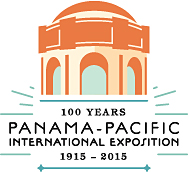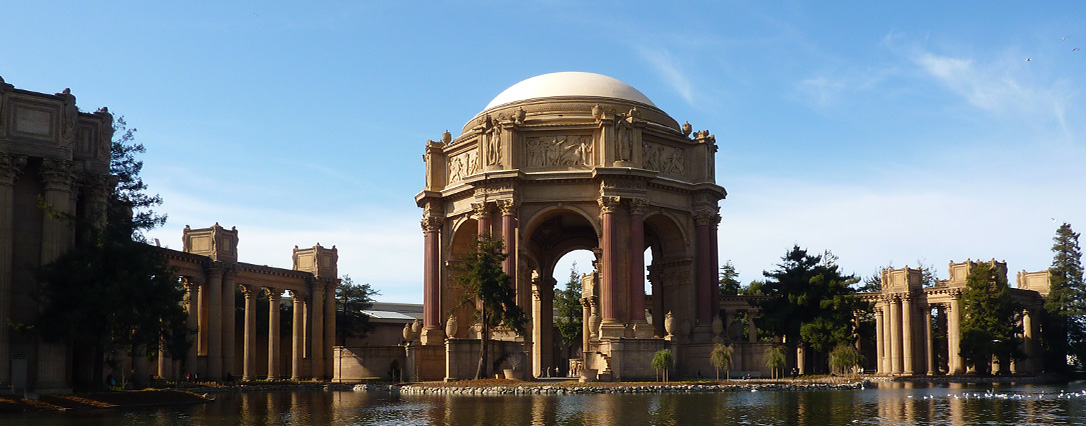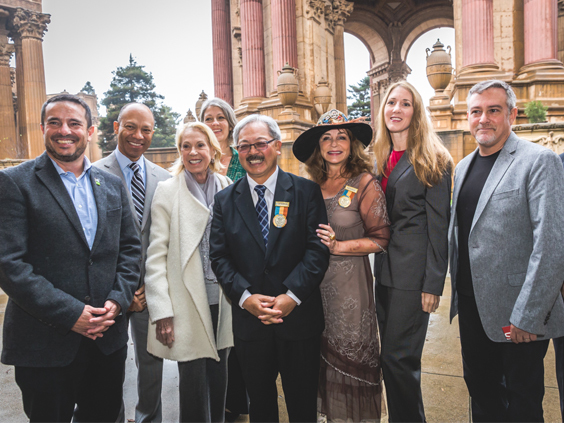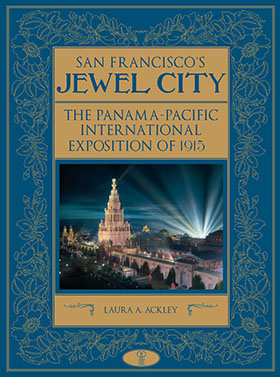SF Mayor Announces Centennial of World's Fair
Yearlong anniversary of 1915 Panama Pacific International Exposition
-
 Panama Pacific International Exposition 100 years logo.
Panama Pacific International Exposition 100 years logo. -
-
This is the first of a series of articles throughout 2015 commemorating Swedes and Swedish-Americans’ participation in this centennial and reflecting the dual pride in their heritage, as Swedes did here a century ago. Like the theme of the commemoration itself — TNT (Then, Now, Tomorrow) — this series will touch upon the past, present and future with the constant themes of innovation, enterprise, arts and heritage amid the transformation of Swedes enchanted by San Francisco and the Bay Area.
-
 Bernard Maybeck designed The Palace of Fine Arts, one of two survivors of San Francisco's second of three world's fairs, the Panama-Pacific International Exposition, 1915. Photo: PPIE100.org
Bernard Maybeck designed The Palace of Fine Arts, one of two survivors of San Francisco's second of three world's fairs, the Panama-Pacific International Exposition, 1915. Photo: PPIE100.org -
-
On December 3, San Francisco’s Mayor Edwin Lee announced that next year (February 21 through December 12, 2015) the city will commemorate the second of its three world’s fairs. The Panama-Pacific International Exposition transformed the meaning of world’s fairs.
Emeritus Professor James Kaplan, who wrote the beautiful article “The Angel of Siberia” in the November 30th issue of Nordstjernan, has also written a very useful historical summary of the Swedish Pavilion and the local community of that period.* However, this series of articles will follow the theme of the centennial — TNT (Then, Now, Tomorrow) — and describe aspects of the fair: yesteryear, the centennial today, and prospects for tomorrow. -
 PPIE celebrities (L-R): Phil Ginsburg (Parks and Recreation general manager); Ken McNeely (AT&T California president); Charlotte Shultz (city’s chief of protocol); Dr. Anthea Hartig (California Historical Society executive director); Mayor Edwin Lee (city and county of San Francisco); Donna Huggins (Mayor Lee’s PPIE100 spokesperson); Laura A. Ackley (author); Dan Shine (CEO, iHangar, curator of Palace of Fine Arts for PPIE100 exhibits).” Photo: PPIE100.org
PPIE celebrities (L-R): Phil Ginsburg (Parks and Recreation general manager); Ken McNeely (AT&T California president); Charlotte Shultz (city’s chief of protocol); Dr. Anthea Hartig (California Historical Society executive director); Mayor Edwin Lee (city and county of San Francisco); Donna Huggins (Mayor Lee’s PPIE100 spokesperson); Laura A. Ackley (author); Dan Shine (CEO, iHangar, curator of Palace of Fine Arts for PPIE100 exhibits).” Photo: PPIE100.org -
Unusual timing boosts interest
The 1915 fair came at an unusual time: only 21 years after the city’s first world’s fair (as a result of which the Swedish American Patriotic League was founded then and there); nine years after San Francisco’s 1906 earthquake and fire; and several years after winning a challenge from New Orleans to host the fair. Oh, and the southern border of California, San Diego was hosting its own Panama-California Exposition this same year! If that weren’t enough of a challenge, San Francisco’s World’s Fair was trying to attract people while half the globe was involved in the Great War. If you build it, would they come? This was one big bet — typical of risky (and risqué) and frisky San Francisco.
Sweden had donated a considerable sum of money to San Francisco’s Swedish survivors of the 1906 catastrophe. These local Swedes were very appreciative and proud of their country, and they wanted it to be represented at this fair of the world’s accomplished nations. They prevailed, for Sweden was one of the initial countries to commit to the fair and the first to break ground for its pavilion. Actually the Nordics were well represented: both Norway and Denmark also had pavilions.
Though it was a century ago and lasted but a year, it is fondly remembered as spectacular and transformative for all future world’s fairs. By their nature, world’s fairs boast the most modern technologies and a resulting novel vision for all using them. But despite this unifying vision, it is also a highly competitive display among nations to claim precedence. And of course, the host nation must try to top whatever else the world offers, in its own contents as much as in the attraction of the exposition.
Originally conceived and proposed by merchant Reuben Brooks Hale in 1904 to emphasize the city’s role as the U.S. portal to the Pacific nations while celebrating the completion of the Panama Canal, deemed the eighth wonder of the world. The manmade canal joined two oceans between two continents.
Everything seemed possible until the morning of April 18, 1906, when the earthquake and fire destroyed much of the city. The catastrophe was devastating and reconstruction efforts seemed insurmountable. The damage exceeded more than 12 billion dollars in today’s currency with more than 3,000 deaths (though that number was not made public until years later). Even while the tent encampments in the city’s parks and ultimately the “earthquake shacks” were being built, the dream of the world’s fair, like the city itself, revived within nine months of the disaster. The vision of the fair further inspired the rebuilding of the city. The fair became a symbol of the indomitable spirit of the city and of its role as the Pacific gateway. The world came to witness the new city as much as to marvel at the fair and to celebrate the canal. Ultimately historian Ackley stated that “the PPIE became the most successful of American world fairs, both financially and in popularity.” -
 Cover of the official centennial PPIE100 book. Image: Laura C. Ackley; Heyday Books
Cover of the official centennial PPIE100 book. Image: Laura C. Ackley; Heyday Books -
Breaking ground inspires more growth
Before it attracted almost 20 million visitors, the city had some other challenges. Top among these was where to put the fair in the resurrected city. Three sites were proposed: Lake Merced near the Pacific Ocean; the western edge of Golden Gate Park (also near the ocean and reminiscent of the site of the city's first world’s fair); and, Harbor View beside the Bay, safely within the Golden Gate strait (the bridge was then but a dream). This last site was chosen as the best financial fit with designated funds, for having the best climate and a superb view, as most accessible for a majority of San Franciscans, and, important to 1906 survivors, the best site for fighting fires.
In 1911 President Taft broke ground for the fair. A fair committee was selected as was a panel of distinguished architects. Frank Morton Todd became official historian, and the necessary 673 acres were gradually acquired. Those living in these far out lands had to sell or lease their land to the city. If leased, their home would either be demolished or moved; after the fair, when all but one was demolished, owners could return to their land, which was now much more valuable. Even so, about 70 acres were submerged beneath a tidal lagoon, yet to be filled in. Some of this area of the subsequently named Marina District liquefied during the 1989 quake and Marina Green was the site for much of the America’s Cup last year.
Once the acreage had been leveled and cleared, the fair construction could begin. One of the factors that made this area so fabled was that the fair was conceived as a walled citadel of towers, colonnades, monumental statues, triumphal arches, fountains and ponds with eight individualized palaces (each featuring a universal aspect of civilization: machinery, art, etc.) and all separated by elegant courtyards. The entire site fronted the beautiful San Francisco Bay just beyond the Golden Gate strait.
Complementing this design, the fair was distinguished by the contributions of three other men and their subcommittees. Jules Guerrin, the director of color, created the palette of more than half a dozen colors unifying all structures. Chief landscape architect John McLaren had already transformed the city’s western sand dunes into Golden Gate Park. Here he walled the main courtyard with imposing eight-feet wide by 20-feet tall hedges of iceplant with 36-feet tall vegetated arched gateways onto the main avenues of the fair. Nothing was left to chance: One million bulbs were ultimately planted to assure that the entire area was always in bloom. -
20th century progress in one city
Previous fairs were impressive daylight affairs. Celebrating the control of electricity in the 20th century, this fair glistened by day — or night. But the iconic, tiered Tower of Jewels, 43 stories tall, shimmered with 102,000 artificial but uniform Novagems in eight specific colors. They glimmered during the day and glittered at night. The tower could be seen from the surrounding hills and across the bay, highlighted further at night by roving spotlights.
Remarkably most of this temporary fair was constructed of wood from the Pacific Northwest. After the fair, the salvaged lumber was sold. This was efficient, ecological and economical because the fair cost $50 million dollars in that day, half of which was paid for by the city and the state as well as by personal and corporate sponsorships. Three of the palaces, however, were constructed of steel: the Tower of Jewels (for its height), the Horticultural Palace; and, the Palace of Fine Arts (required by the insurance companies to insure the world’s art within).
Bernard Maybeck’s elegant Palace of Fine Arts surrounded by its lagoon (rescued from a swamp) is the only survivor of these temporary buildings. Berkeley’s Maybeck was not even on the architectural panel. However, when flummoxed, the distinguished San Franciscan architect Willis Polk, assigned to design this palace, turned to his friend, who in a weekend sketched the remarkable palace, which gained universal acclaim. Maybeck told Polk that the muddy pond was the solution, not the problem. The issue was to transform it into a beautiful landscaped reflecting pool.
One of the most remarkable aspects of the fair, apart from its stunning appearance, was that in order to compete for awards, any exhibit or invention had to have been created within the preceding decade. This emphasis on the new therefore featured electricity, motor cars, trains, planes as well as all manner of new and useful gadgets and novel manufacturing processes.
A huge Palace of Machinery with three bays each 75 feet wide, 101 feet tall and almost 1000 feet long, was the largest wooden structure in the world for its time. A 14-ton model of the Underwood typewriter automatically typed out the latest news and Hearst bought the largest and latest presses to produce his daily San Francisco Examiner hot off the presses right at the fair. The 11,000 square foot U.S. Post Office, demonstrated its modernization in sorting and delivery. While you watched, your letter or postcard, postmarked from the fair, was speedily segregated for the quickest delivery.
At the Palace of Transportation, a Ford plant produced 18 cars a day, displaying the marvel of the assembly line, as did Levis’ onsite factory. Out on the fair’s airstrip, a small plane company named Loughead took off many times daily to offer aerial views of the fair and surrounding Bay Area. It was so successful that it changed its name to Lockheed, and the rest is history. A couple acres were dedicated to a stationary model of the Grand Canyon. And of course the PPIE would not be complete without celebrating the newest wonder of the modern world with a five-acre model of the Panama Canal itself, demonstrating the locks and trains which guided ships between the two oceans. This model was designed by Joseph Strauss of Strauss Aeroscope, later to become a local legend as the chief engineer of the Golden Gate Bridge.
To the west of the main fairground, for some 270 acres of the Presidio, a triangular wedge bordered the bay. At the tip of this wedge of federal land were an athletic field, parade grounds, a livestock stockade and an airport. Between Lyon and Laguna streets and from Chestnut Street east for about 10 blocks lay the principal palatial and courtyard sector. Four blocks west of Laguna lay the Midway, also known as the Joy Zone, where concessionaires offered refreshments, dazzling displays and thrilling experiences. -
Celebrating a century's innovative spirit
A century ago at this fair, AT&T demonstrated the first transcontinental telephone call, the result of stringing 3,400 miles of telephone wire on countless poles. Several weeks before the fair Alexander Graham Bell in New York called Watson in San Francisco and together they talked with President Wilson in Washington, DC. Fittingly, AT&T is now the principal sponsor of the centennial.
The Civic (now Bill Graham) Auditorium at Civic Center plaza was originally designed to become the only permanent structure remaining after the Fair. However, citizens determined that the Palace of Fine Arts (PFA) should also survive the fair. As beautiful, beloved and romantic a landmark as this is — reputedly the most photographed wedding spot in the country — it was all but destroyed at several periods during the century. Only the championing by Phoebe Apperson Hearst and the raising of half a million dollars after the fair spared this temporary building. In the 1960s a generous gift from neighbor Walter Johnson inspired others to raise the money to reconstruct a more permanent structure. Yet again in the 1990s as well as in 2003 the palace was rescued financially and strengthened structurally. It is significant that Mayor Lee and Phil Ginsburg, today’s manager of the owning agency, the Department of Recreation and Parks, both played roles in restoring the Palace of Fine Arts.
For all of these reasons, although rain had already begun to fall in the parched city, the mayor with his Asian heritage saw this as propitious of good fortune. He emphasized that this fair is one of the touchstones of the city’s past, a reminder that innovation began here yesteryear and continues today. This past, idolized now in the refurbished PFA, is a talisman for our future, beckoning us to continue our collaboration and innovation. At the same time this mystic structure symbolizes the remarkable feats created right here long ago. It is testimony to this evanescent moment, memorable for a lifetime and beyond. It is fortunate that these grounds and edifice have not been allowed to decay (or worse yet, be modernized) into some tawdry amusement park, like a worn out starlet. Much as with Golden Gate Park and other landmarks, we today are greatly indebted to civic-minded neighbors who realized the value of rescuing the past as a beacon to the future.
In his remarks during PPIE100, Dan Shine of iHangar, the current curator of the PFA, also reminded us of the importance of place. In the Palace of Fine Arts for this centennial year, this serial high-tech entrepreneur and adviser to the president celebrates San Francisco’s innovative spirit by transforming the PFA into a public innovation lab, “Where the curious can play, grow and learn” by collaborating “and where the dreamers of today can inspire our world tomorrow.” Coincidentally this is the theme of Walter Isaccson’s best selling new book, "The Innovators," documenting that such collaboration is essential for any innovation community. In turn this contributes to the beauty, progress, education and lifestyle that attracts so many to such urban environs.
Dr. Anthea Hartig, executive director of the California Historical Society, the principal coordinator in the PPIE100 centennial celebration, has partnered with the Parks and Recreation Department, the city’s lead agency in this effort. She stated: “We are thrilled to work with so many partners and collaborators to help bring back the spirit of the PPIE and the 1915 World’s Fair to San Francisco.”
As well as being principal sponsor for the centennial, Ken McNeely, president of California AT&T, indicated they are donating another $50,000 for the student Passports to Success program, inspiring students to learn here how to innovate and the role of innovations for society.
At the conclusion of the ceremony, Dr. Hartig thanked the city’s chief of protocol, Charlotte Maillard, and the mayor’s official spokesperson, Donna Huggins (“the Fair Dame of the centennial”). He also called author Laura C. Ackley to the stage, where the author presented her book to the mayor. The official book of the fair just published by Heyday Books is "San Francisco’s Jewel City."* All the dignitaries then opened the huge iron doors of the palace onto the exquisite rotunda, as the rain stopped. -
By Ted Olsson
PPIE100 Partner
San Francisco -
• Footnotes:
1) To download the pdf of Kaplan’s article, “For the Future: the Swedish Pavilion at the Panama Pacific International Exposition of 1915,” go to For the Future: The Swedish Pavilion at the Panama Pacific International Exposition of 1915 by James Kaplan
2) Visitors and viewers can find more information at the official commemoration website, www.PPIE100.org
3) Ackley, Laura A. San Francisco’s Jewel City: the Panama-Pacific International Exposition of 1915. Berkeley; Heyday, 2014 -
-
